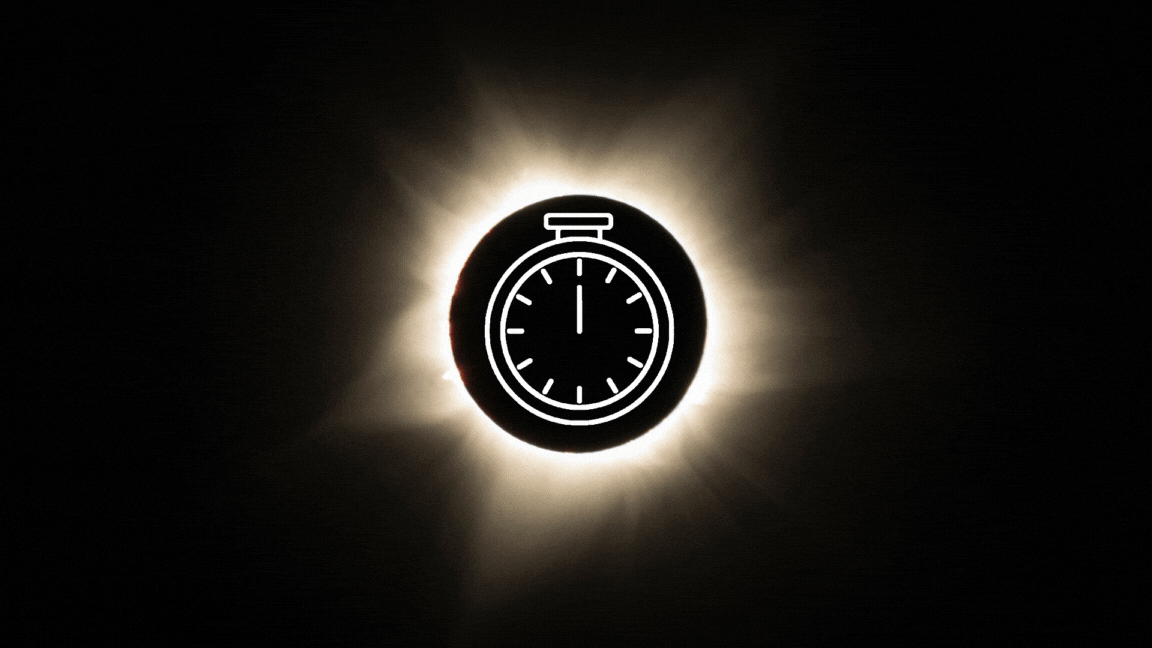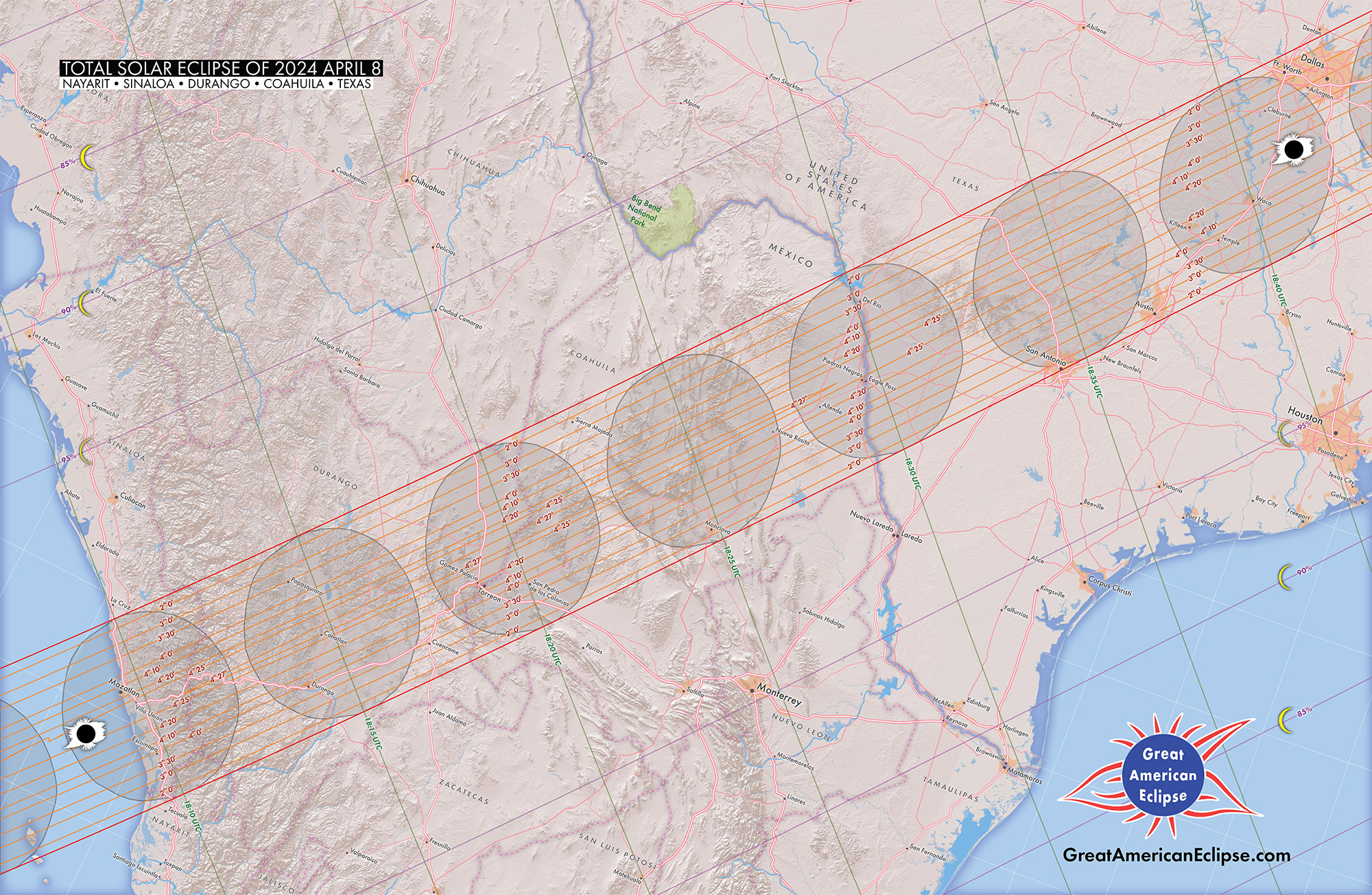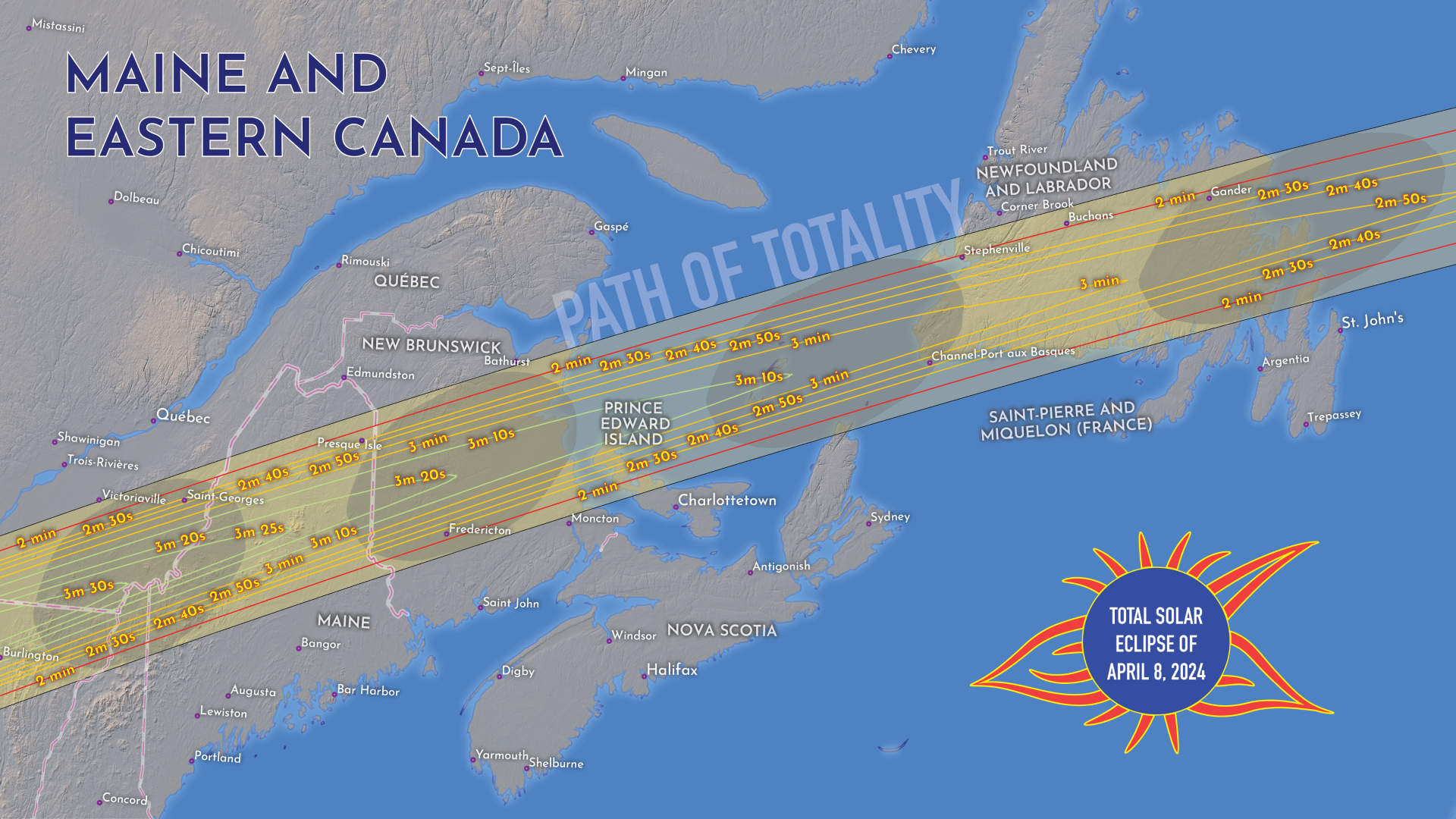How long will April's total solar eclipse last?
How long the total solar eclipse lasts will entirely depend on where you are.

On April 8, a total solar eclipse will be visible from parts of North America, with the entire continent at least seeing partial phases.
How long the total solar eclipse portion of the event lasts depends on where you are along and within the path of totality.
If you're unable to see the eclipse in person, you can watch the total solar eclipse live here on Space.com. And keep up with all the actions with our total solar eclipse 2024 live updates blog.
Related: How fast will April's total solar eclipse travel?
Totality across North America
The first moment of totality to be seen on the planet will be at 12:38 p.m. EDT (1638 GMT) and the last at 3:55 p.m. EDT (1955 GMT), a sum of 3 hours, 16 minutes and 45 seconds. This is the effect of the moon's umbra, its dark central shadow, which will create a path of totality about 115 miles (185 kilometers) wide, diagonally across parts of the North American continent.
Total duration of totality:
- Totality in Mexico: 40 minutes 43 seconds
- Totality in the U.S.: 67 minutes 58 seconds
- Totality in Canada: 34 minutes 4 seconds
Earth is spherical, and so is the moon. When the moon's shadow strikes Earth, it does so obliquely as a stretched oval, becomes a more circular shadow at the point of greatest eclipse, and then stretches again.
Get the Space.com Newsletter
Breaking space news, the latest updates on rocket launches, skywatching events and more!
You have to be in the path of the umbra — the dark inner part of the moon's shadow — to experience totality. Your experience depends not only on where you are located along the path but also on how close you are to its centerline. The closer you are to the centreline, the longer the duration of totality.
But don't worry too much about getting as close as possible to the centerline. "People visiting the path of totality this April 8 do not need to go to the path center to get a long-duration eclipse," Michael Zeiler, eclipse cartographer at GreatAmericanEclipse.com, told Space.com. "You can get 90% of the maximum totality by driving 60% of the distance from path edge to center," Zeiler continued.
So, how long the total solar eclipse lasts depends entirely on where you are, but all this needs context. The total solar eclipse of 2010 was the last time it was possible to experience a totality of over four minutes, with the last in the U.S. in 2017 lasting a maximum of 2 minutes 42 seconds. Besides, the most important thing on April 8 is to be anywhere inside the path of totality where the sky is clear.
How long the eclipse will last across notable locations
| Location | Totality (local time) | Totality duration |
|---|---|---|
| Mazatlán, Sinaloa, Mexico | 11:07 a.m. MST | 4 minutes 20 seconds |
| Durango, Durango, Mexico | 12:12 p.m. CST | 3 minutes 50 seconds |
| Torreón, Coahuila, Mexico | 12:16 p.m. CST | 4 minutes 11 seconds |
| Piedras Negras, Coahuila, Mexico/Eagle Pass, Texas, U.S | 1:27 p.m. CDT | 4 minutes 24 seconds |
| Kerrville, Texas, U.S | 1:32 p.m. CDT | 4 minutes 25 seconds |
| Fredericksburg, Texas, U.S | 1:32 p.m CDT | 4 minutes 25 seconds |
| Dallas, Texas, U.S | 1:40 p.m. CDT | 3 minutes 52 seconds |
| Idabel, Oklahoma | U.S: 1:45 p.m CDT | 4 minutes 19 seconds |
| Russellville, Arkansas, U.S | 1:49 p.m. CDT | 4 minutes 12 seconds |
| Cape Girardeau, Missouri, U.S | 1:58 p.m. CDT | 4 minutes 7 seconds |
| Carbondale, Illinois, U.S | 1:59 p.m. CDT | 4 minutes 10 seconds |
| Bloomington, Indiana, U.S | 3:04 p.m. EDT | 4 minutes 3 seconds |
| Indianapolis, Indiana, U.S | 3:06 p.m. EDT | 3 minutes 51 seconds |
| Cleveland, Ohio, U.S | 3:13 p.m. EDT | 3 minutes 50 seconds |
| Erie, Pennsylvania | U.S: 3:16 p.m. EDT | 3 minutes 43 seconds |
| Rochester, New York, U.S | 3:20 p.m. EDT | 3 minutes 40 seconds |
| Montpelier, Vermont, U.S | 3:27 p.m. EDT | 1 minutes 42 seconds |
| Oakfield, Maine, U.S | 3:31 p.m. EDT | 3 minutes 23 seconds |
| Niagara Falls, Ontario, Canada | 3:18 p.m. EDT | 3 minutes 31 seconds |
| Montreal, Quebec, Canada | 3:26 p.m. EDT | 1 minute 57 seconds |
| Miramichi, New Brunswick, Canada | 4:34 p.m. ADT | 3 minutes 8 seconds |
| Tignish, Prince Edward Island, Canada | 4:35 p.m. ADT | 3 minutes 12 seconds |
| Catalina, Newfoundland, Canada | 5:13 p.m. NDT | 2 minutes 53 seconds |
Maximum totality at sunrise
As the eclipse begins at sunrise south of Starbuck Island in the Pacific Ocean at 6:24 a.m. local time on April 9 (1624 GMT April 8) the moon's shadow will be as far from the moon as it can get. The path of totality — the width of the moon's shadow — will be 89.5 miles (144 kilometers) when it first appears on Earth. Consequently, the totality will be shorter, lasting just 2 minutes and 6 seconds.
Point of greatest eclipse

About 5,000 miles later is the point of greatest eclipse, where totality will last 4 minutes 28 seconds from 12:15 CST (1715 GMT) over a tiny town called Nazas about 25 minutes northwest of Torreón in the state of Durango, Mexico.
At this point, the moon will be as close to Earth as it gets during the eclipse simply because Earth is spherical. It's over Nazas that the centers of the moon, Earth and sun are perfectly aligned. Here, the path of totality will be 123 miles (197km) wide — the widest it gets during the eclipse.
Maximum totality at sunset

As the eclipse ends at sunset in the Atlantic Ocean at 4:53 p.m. EDT (2053 GMT) on April 8, the moon's shadow will again be as far from the moon as possible. The path of totality here will be just 88 miles (142 km) wide when it last appears on Earth. This final totality will last 2 minutes and 3 seconds.
Join our Space Forums to keep talking space on the latest missions, night sky and more! And if you have a news tip, correction or comment, let us know at: community@space.com.

Jamie is an experienced science, technology and travel journalist and stargazer who writes about exploring the night sky, solar and lunar eclipses, moon-gazing, astro-travel, astronomy and space exploration. He is the editor of WhenIsTheNextEclipse.com and author of A Stargazing Program For Beginners, and is a senior contributor at Forbes. His special skill is turning tech-babble into plain English.









